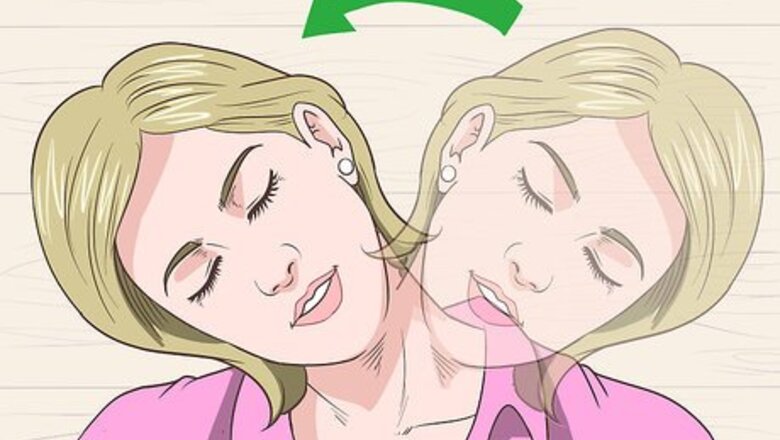
views
X
Trustworthy Source
Cleveland Clinic
Educational website from one of the world's leading hospitals
Go to source
Stretch and exercise routinely, and practice healthy body mechanics during all of your daily activities. If you do experience pain or swelling, or if you hear a low-pitched pop instead of a high-pitched crack, seek medical attention instead of trying to stretch or exercise.
Stretching to Improve Mobility
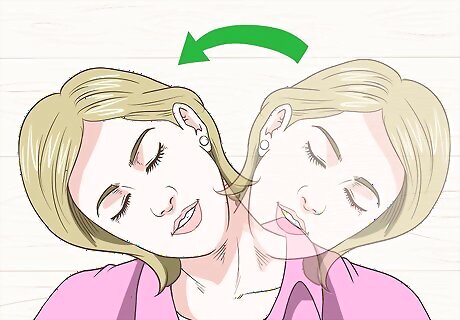
Stretch your neck gently to promote spinal health. If you frequently experience a creaky neck, try facing forward, then tilt your head to the left and bring your ear close to your shoulder. Hold the stretch for 30 seconds, then repeat on the other side. After tilting your head to each side, face forward, then slowly turn your head to the left as far as you comfortably can. Hold it for 30 seconds, then turn slowly to the right and repeat the stretch on that side. To finish up your neck stretches, face forward, then lower your chin toward your chest until you feel a stretch in the back of your neck. Hold the stretch for 30 seconds, then slowly return to the starting position.

Perform Y, T, and W stretches to loosen your shoulders. Stand up straight with your feet hip-width apart and your knees slightly bent. To perform Y stretches, raise your arms above your head so your body looks like the letter Y. Extend your arms and fingers as far as you can, hold the stretch for 30 seconds, and bring your arms back to your sides. Next, do a T stretch by raising your arms out to your sides so your body looks like the letter T. Extend your arms as far as you comfortably can, hold the stretch for 30 seconds, then bring your arms back to your sides. Finish by bring your arms back to the T position, then bend your elbows with your palms facing toward your head so your arms resemble the letter W. Hold the stretch for 30 seconds, then lower your arms to your sides. Try doing 5 sets of 30-second stretches for each pose.

Do 5 standing quad stretches per leg. Stand with your feet hip-width apart, then bend your left knee backward to bring your foot near your rear end. Grab your left toe with your left hand, and gently lift until you feel a stretch in your quad, or front thigh muscle. Hold the stretch for 30 seconds, then repeat on the other leg. Hold the wall or the back of a chair to help keep your balance. Do 5 sets of 30 second stretches on each leg.
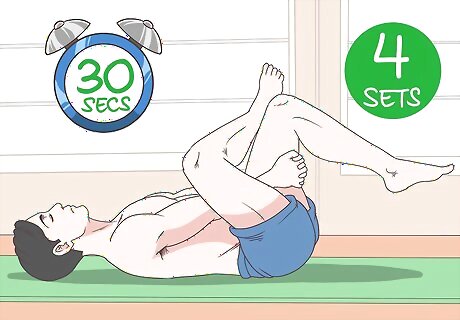
Try figure 4 stretches to relieve hip popping. Start by lying on your back with your feet flat on the floor and knees bent. Raise your left foot and rest it on your right knee so you left sole faces toward the right. Clasp your hands behind your right thigh, and raise your right leg until you feel a stretch in your hip and buttocks. Hold the stretch for 30 seconds, return to the starting position, and repeat the pose on the other side. Do 3 sets of 4 repetitions per leg.
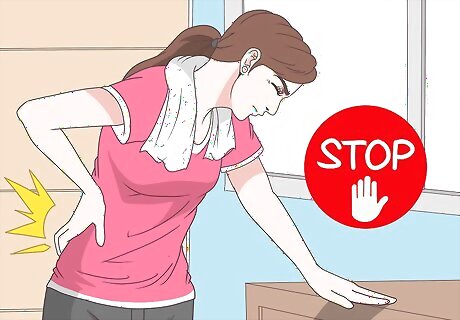
Avoid stretching or exercising if you experience pain or swelling. See your doctor if you experience pain or swelling, or if you heard a low-pitched, painful pop during an activity. Popping or cracking joints is usually normal and, for the most part, unavoidable. However, joint pain or swelling could indicate an injury, arthritis, or other issue that might require medical attention. A high-pitched crack without pain is usually just the release of gas bubbles in a joint. A painful, low-pitched pop might be a ruptured tendon, dislocated joint, or stress fracture.
Exercising for Joint Health

Try to exercise for 30 minutes a day, 5 days a week. Aim for a total of 150 minutes of exercise per week. Aerobic exercises, such as walking, light jogging, and cycling are especially beneficial for your joints. Talk to your doctor before you start a new exercise routine, especially if you have a history of heart, bone, or joint issues.
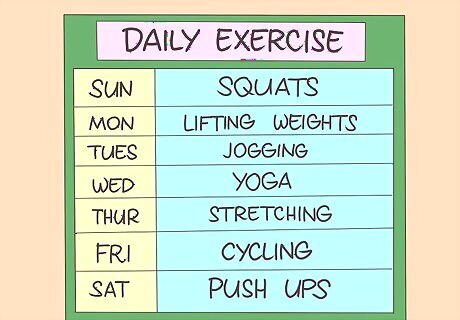
Vary your exercises and physical activities. Regular, varied exercise is good for your joints, but repetitive motions can cause chronic injuries. Try to exercise different parts of your body each day. If you have to perform repetitive motions at work, take breaks to stretch every 15 to 30 minutes. To vary your exercise routine, try lifting weights on Monday, going for a jog on Tuesday, yoga or stretching on Wednesday, and ride your bike on Thursday.
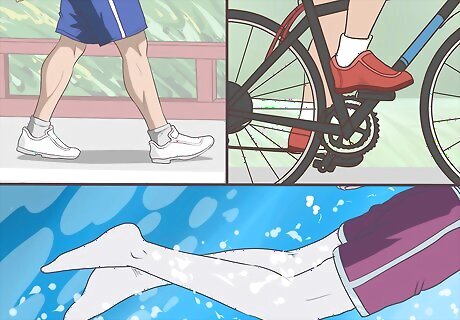
Walk, cycle, and swim to strengthen your legs. If your knees, hips, and ankles frequently crack, focus on strengthening your leg muscles to reduce the strain on these joints. Go for brisk walks or jogs, ride your bike, swim laps, or use resistance machines at your gym. If you have a history of joint issues, stick to low-impact activities, such as walking and swimming. To minimize joint strain, try to walk on flat, padded tracks instead of hard surfaces and inclines.
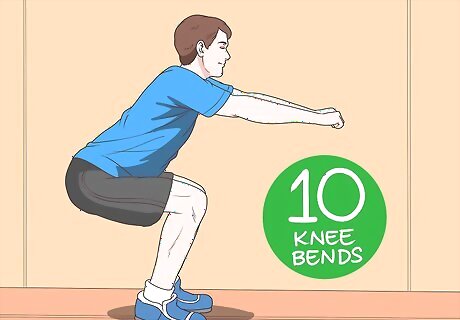
Perform 10 knee bends during breaks at work. Stand with your feet hip-width apart and arms extended in front of you. Bend your knees and extend your buttocks backward to lower your body by about 4 to 5 inches (10 to 13 cm). Face forward as you bend your knees, keep your back straight, and align your knees with the second toe on each foot. Avoid extending your knees past your toes. Stay down for 1 to 2 seconds, return to the starting position, and do a total of 10 repetitions. Knee bends are a great way to get moving during breaks at work or when you don't have time to go for a walk.
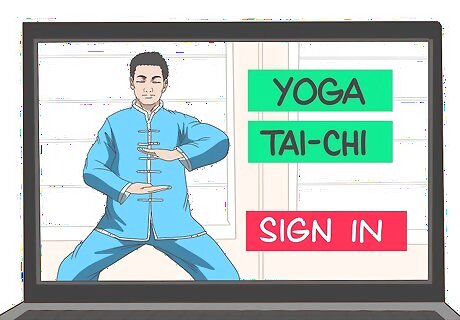
Sign up for a yoga or tai chi class. While taking classes will ensure you maintain proper form, you could also look online for instructional videos. In addition to improving joint health and improving flexibility, yoga and tai chi can improve balance and prevent falls.
Practicing Healthy Body Mechanics
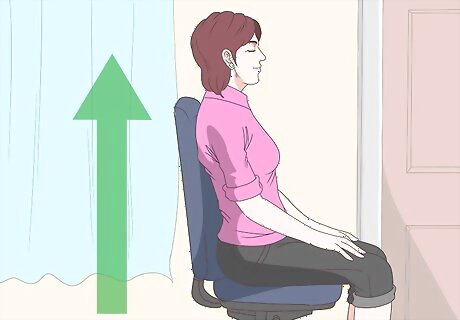
Sit upright with your back supported and feet flat on the floor. Avoid crossing your legs or slouching while you sit. Bend your knees at 90-degree angles, and try to keep them aligned with your hips. Sit up straight, but maintain your back's natural curves, which resemble the curves of the letter S. Try using a lumbar pillow to support the curve in your lower back. Keep a small gap between the edge of your seat and the back of your knees. Maintain good posture throughout the day, whether you're at your desk, driving or walking.

Avoid sitting for more than 30 minutes at a time. If you work in an office or have to sit for long periods, try to get up and stretch at least every half hour. Staying in the same position for long periods of time can cause your joints to lock up and creak. When you get up and move around, try doing neck stretches, shoulder stretches, and knee bends. If possible, go for a walk around your office or up and down a hallway.
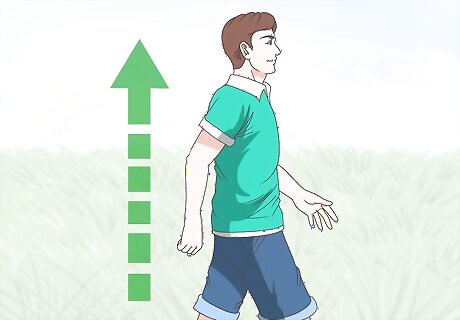
Walk with your chest lifted and knees, hips, and feet aligned. Maintain an upright position as you walk, and avoid slouching or staring down at your phone. Try not to let your ankles roll or allow your knees to collapse inward, and keep your hips from tilting up and down. Point your toes forward as you walk, and keep your knees aligned with your toes when you bend them. Improper walking posture can lead to long-term joint issues. If your knees, ankles, and hips fall out of alignment, you might hear your tendons crack and pop as they rub against bones. Over time, this friction can result in joint damage.

Lift objects with your legs instead of your back. Never bend over from your waist and lift objects with your back. Instead, face forward, keep your torso straight, bend your knees and stick your rear end out as you lower yourself toward the ground. Bring the object as close to your body as you can, and raise your body by steadily straightening your legs. Keep your legs in a wide stance when you lower yourself to pick up the object. When you lift, straighten your legs steadily instead of using jerking motions. Engage your abdominal muscles as you lift to maintain your core's stability.

Sleep on your side or back instead of your stomach. If you usually wake up with sore, creaking joints, changing your sleeping position might help. Sleeping on your stomach flattens your spine's natural alignment and can cause back pain. Instead, sleep on your side or back, and use pillows to cushion your legs. If you sleep on your side, place a pillow between your knees. If you sleep on your back, place a pillow under the backs of your knees. John E. Sarno John E. Sarno, Rehabilitation Medicine Professor Comprehending the fundamental causes of physical unease, such as cracking and popping joints, frequently necessitates looking beyond just the outward symptoms. In many cases, these corporeal manifestations can be connected to emotional anxiety or strain. By tackling those fundamental emotional factors, we can start to mitigate the bodily symptoms. It is imperative to regard the body as an integrated system, where the mind and body operate in harmony. Methods like mindfulness, stress alleviation, and acknowledging the influence of emotional well-being on physical health can be exceptionally effective in reducing or eliminating the incidence of joint noises.











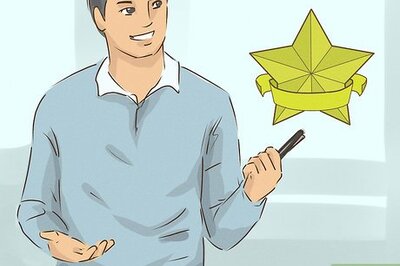






Comments
0 comment